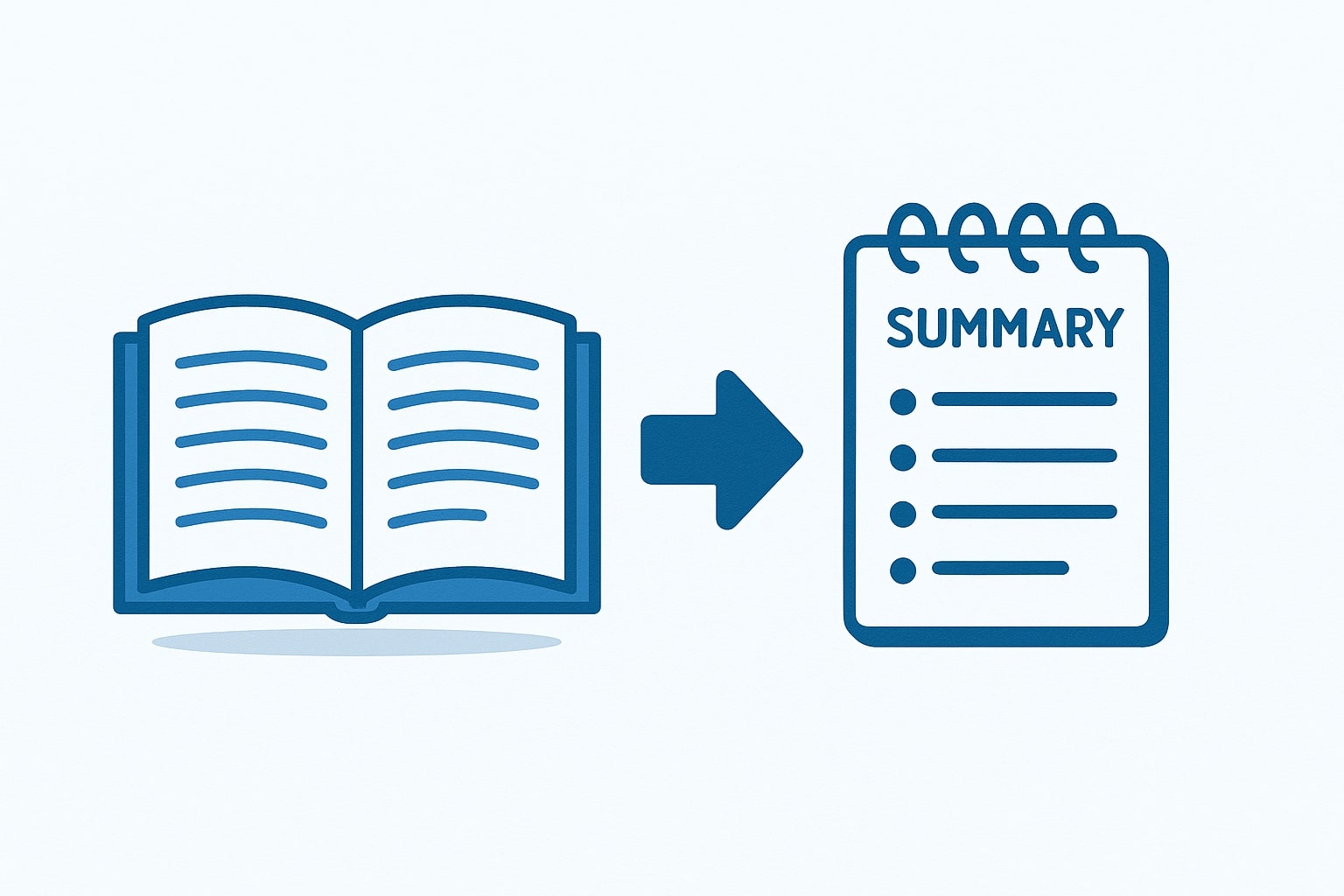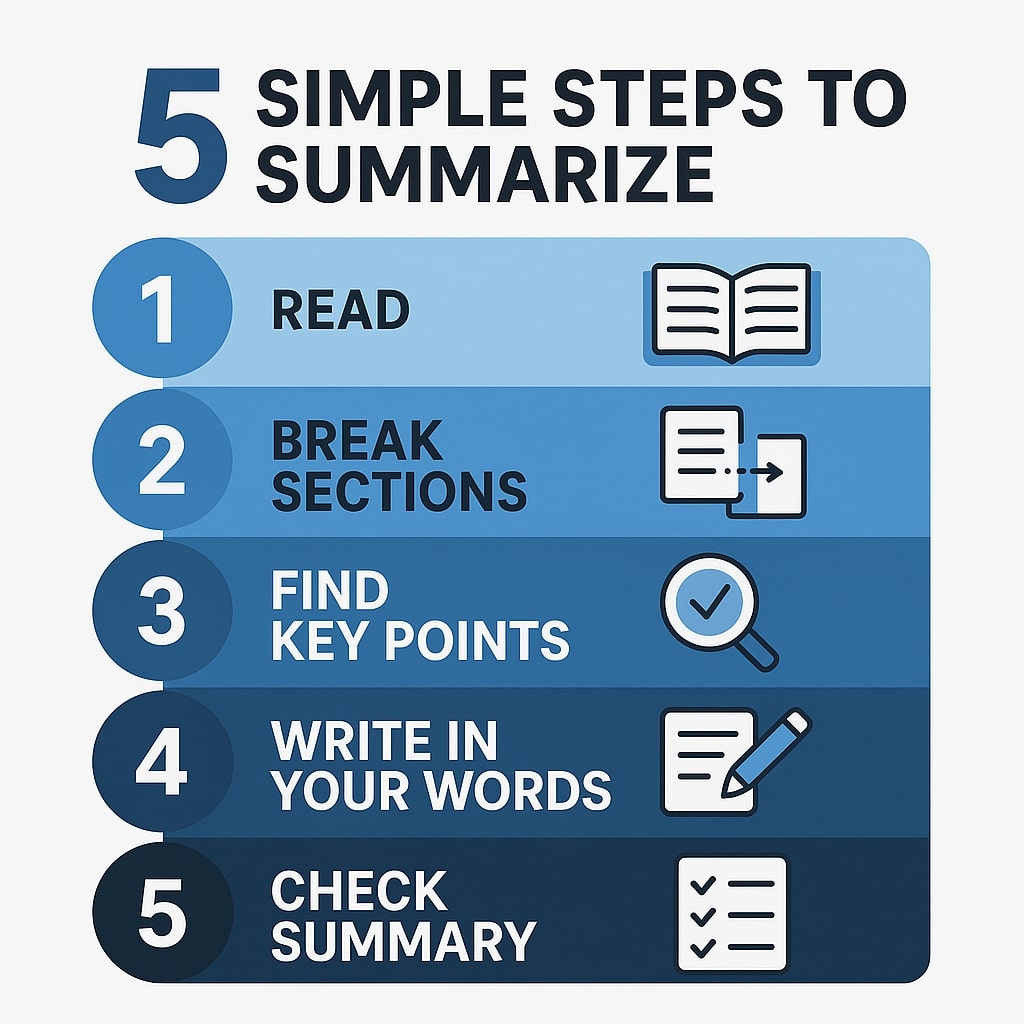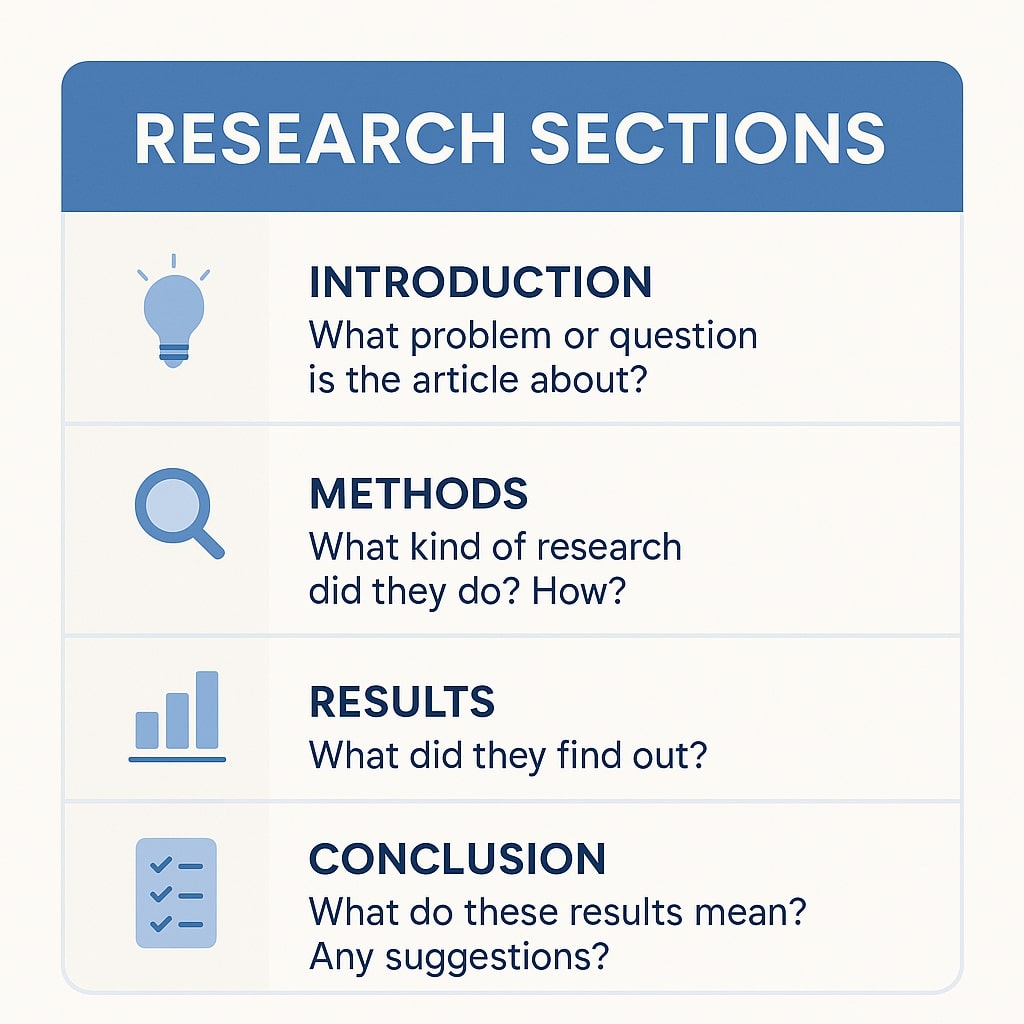How to Write a Summary | Tips, Steps & Examples
Learn how to write a clear and simple summary in 5 easy steps. See examples, tips, and how to use tools for quick summaries.

Writing a summary means explaining the main ideas of a text in a shorter form using your own words. A good summary tells what the original text is about without adding your opinion. It should be much shorter than the original version.
In this guide, you’ll learn how to write a clear and useful summary in five simple steps:
- Read the text carefully
- Break it into smaller sections
- Find the main points
- Write the summary in your own words
- Check your summary
You don’t need to judge or analyze the original text. Just explain the important ideas clearly and briefly.
When Should You Write a Summary?
Summaries are helpful in many situations. You might need to write one:
- As a school or college assignment
- When taking notes on a book, article, or video
- When doing research and reading other people’s work
- When writing essays or reports and referring to sources
For example, you might write a brief one-sentence summary for a note, a short paragraph for a literature review, a detailed summary for a research report, or an executive summary to introduce a business document.
No matter the situation, a summary helps others understand the main idea of the original text — quickly and clearly.
Depending on your purpose, the type of summary you write may vary. For example, you might write a brief one-sentence summary for a note, a short paragraph for a literature review, or a detailed summary for a research report.

Step 1: Read the Text Properly
To write a good summary, you must understand the original text first. It’s best to read the text more than once.
Here’s how to do it:
- First reading: Quickly scan the text to understand the topic.
- Second reading: Read slowly and carefully. Highlight or write down important points.
- Third reading: Skim again to make sure you’ve understood everything.
Some tips to help you during reading:
- Look at the title, headings, and subheadings — they show what each part is about.
- Read the introduction and conclusion — they often explain the main idea.
- If the article has an abstract, read that first — it gives a short overview.
Step 2: Break the Text into Sections
Breaking the text into smaller parts makes it easier to understand and summarize.
Scientific articles usually have clear sections like:
- Introduction
- Methods
- Results
- Discussion
Essays or opinion articles may not have these labels but are often divided into logical paragraphs or themes. You can write short notes in the margin for each paragraph — for example: “main idea,” “example,” or “background info.”
Grouping similar paragraphs together helps you see the big picture.
Step 3: Find the Key Points
Now, go section by section and find the main ideas. Ask yourself:
- What is this part trying to say?
- Which information is needed to understand the whole article?
- What can I skip because it’s too detailed or repeated?
If it’s a research article, look for:

If the text is not a study, focus on:
The main claim or thesis — usually found in the intro
Topic sentences — the first line of a paragraph often tells the main point
Any important examples or facts used to support the point
Leave out examples, detailed data, or extra background unless they’re really important.
Step 4: Write the Summary in Your Own Words
Now that you understand the key points, it’s time to write your summary.
Don’t copy sentences from the article. Use your own words to show you understand the text. This helps avoid plagiarism.
Here’s a tip: Put the article aside and try to explain the main ideas like you would to a friend.
Let’s look at an example:
Article Topic:
Does eating an apple a day really keep the doctor away?
Example of a Full Summary:
Davis et al. (2015) explored whether the saying “an apple a day keeps the doctor away” is true. They used health survey data to compare people who eat apples with those who don’t. They looked at doctor visits, hospital stays, and medicine use. The results showed that apple eaters were slightly more likely to avoid using prescription drugs, but there was no strong link to fewer doctor visits or hospital stays. The study suggests apples may help reduce medicine use, but more research is needed. The authors also said that healthy people may be more likely to eat apples, which could affect the results.
Example of a Short Summary:
Davis et al. (2015) studied if eating apples leads to fewer doctor visits. They found no strong link, but apple eaters were slightly less likely to take prescription medicine.
Use this format when writing summaries for:
Research papers
- Articles in literature reviews
- News or opinion pieces
- Chapters of books
Step 5: Check Your Summary
Before finishing, always check your summary against the original article:
☑️ Did you include the main points?
☑️ Did you leave out extra details and opinions?
☑️ Did you use your own words instead of copying?
☑️ Is the summary shorter than the original?
☑️ Is it clear and easy to understand?
Reading both side-by-side can help you spot missing or repeated ideas.
A Useful Tool to Help You Summarize Text Quickly And Easily
Want to speed things up? Use our free AI summary generator.

Just paste your text and get a quick summary of the key points. It’s perfect for students, researchers, and anyone who needs fast, clear summaries.
Frequently Asked Questions
What is a summary?
A summary is a short version of a longer text. It tells the main ideas in your own words.
How long should a summary be?
It depends on the original text. Usually, it’s one-third or less of the original length.
How do I avoid plagiarism in a summary?
Don’t copy phrases. Understand the text first, then rewrite the ideas yourself.
Is a summary the same as an abstract?
No. An abstract is written by the original author to describe their own work. A summary is written by someone else after reading the full text.
